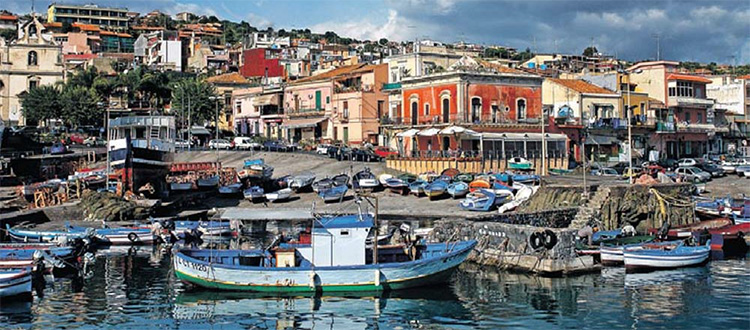Aci Trezza
Aci Trezza
Aci Trezza ( ‘a Trizza in Sicilian ) is a district of the small municipality of Aci Castello, in the metropolitan city area of Catania. A fishing village with an old and remarkable tradition, it is famous for its scenery. It looks directly onto the Ionian Sea and is approximately nine kilometers from Catania. The view of Aci Trezza is dominated by the large jagged rock formations of the Cyclops coast: eight picturesque basalt rocks that, so goes the legend, were thrown by Polyphemus at Ulysses as the latter fled. Not far from the coast (about 400 meters away), there is the island of Lachea, identified as the Homeric island of Capre and which now houses the center for biology studies of the University of Catania.
The whole area has been recognized a marine reserve since 2004. Aci Trezza was officially founded in the late seventeenth century by Stefano Riggio. The choice was not accidental, since the latter had been the owner, since 1651, of the cities of Aci Sant’Antonio and San Filippo.
Aci Trezza and The Sea
Particularly striking is the walk towards the sea at Acitrezza, to the marina, which is situated just across Piazza Giovanni Verga, where you can meet the local boatmen ferrying tourists, on their typical local rowing boats, to the Cyclops Rocks. Right in the middle of the marina square, on the seafront, there is the fish market, famed for the good fish to be found there, and open from 2.00am until 6:00 am.
Aci Trezza and Art
This was the place where the great Sicilian writer Giovanni Verga set his famous novel I Malavoglia (1881) (The unwilling) and in 1948 the film inspired by it (The earth trembles by Luchino Visconti and Antonio Pietrangeli) was shot here. Considered a masterpiece of neorealism, it was made with non-professional local actors.
Not far from the Chiesa del Patrono (Church of the Patron), according to certain descriptive elements provided by Verga in I Malavoglia, was the “home of the medlar tree” (the home of Padron ‘Ntoni). There a small museum now exists containing objects of ancient maritime tradition and a photographic section dedicated to Luchino Visconti’s film. Visits that are simply unmissable are to the La Chiesa di San Giovanni Battista (the Church of St. John the Baptist), in the central square, and La Casa del Nespolo (The House of the Medlar Tree).



